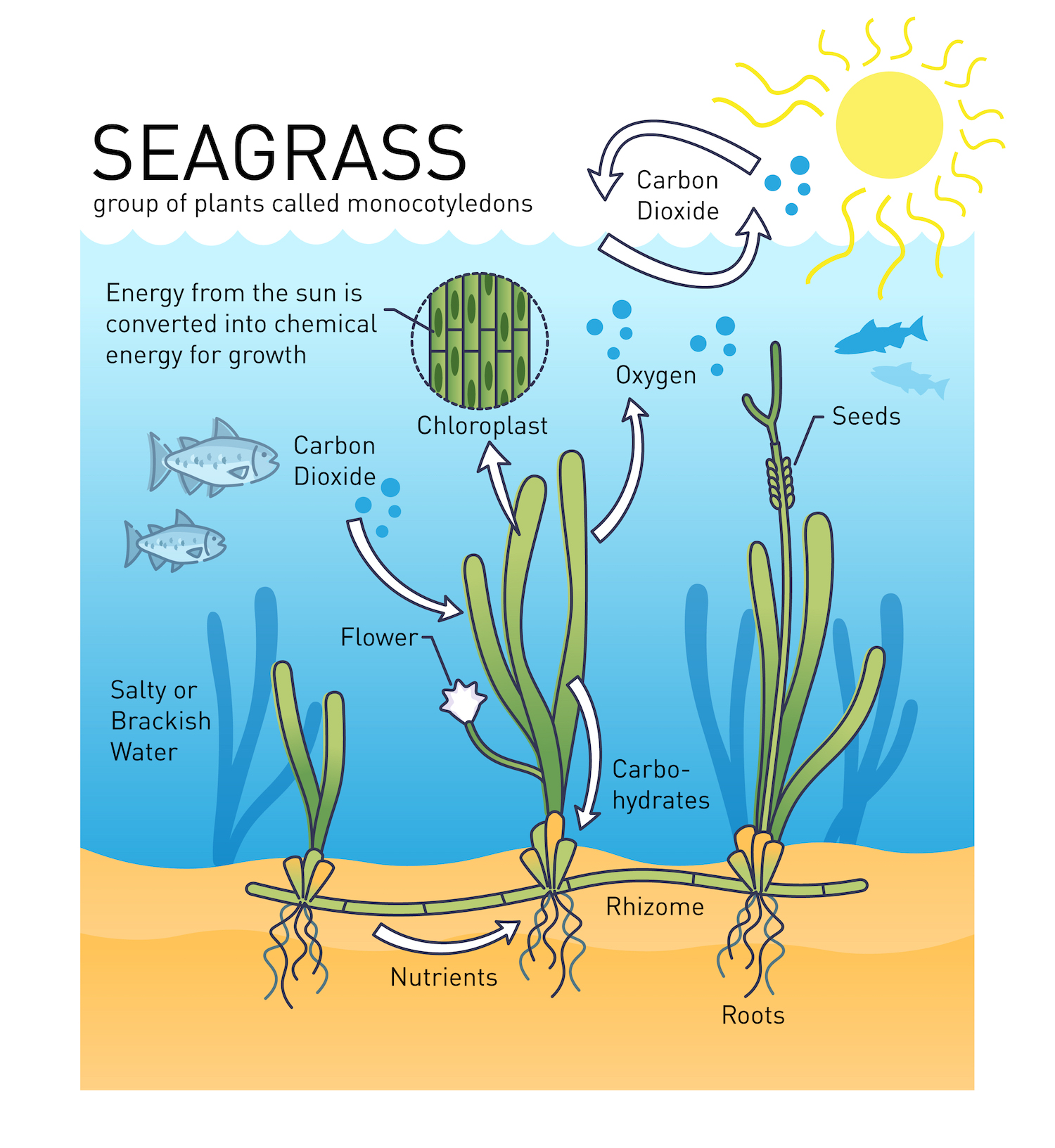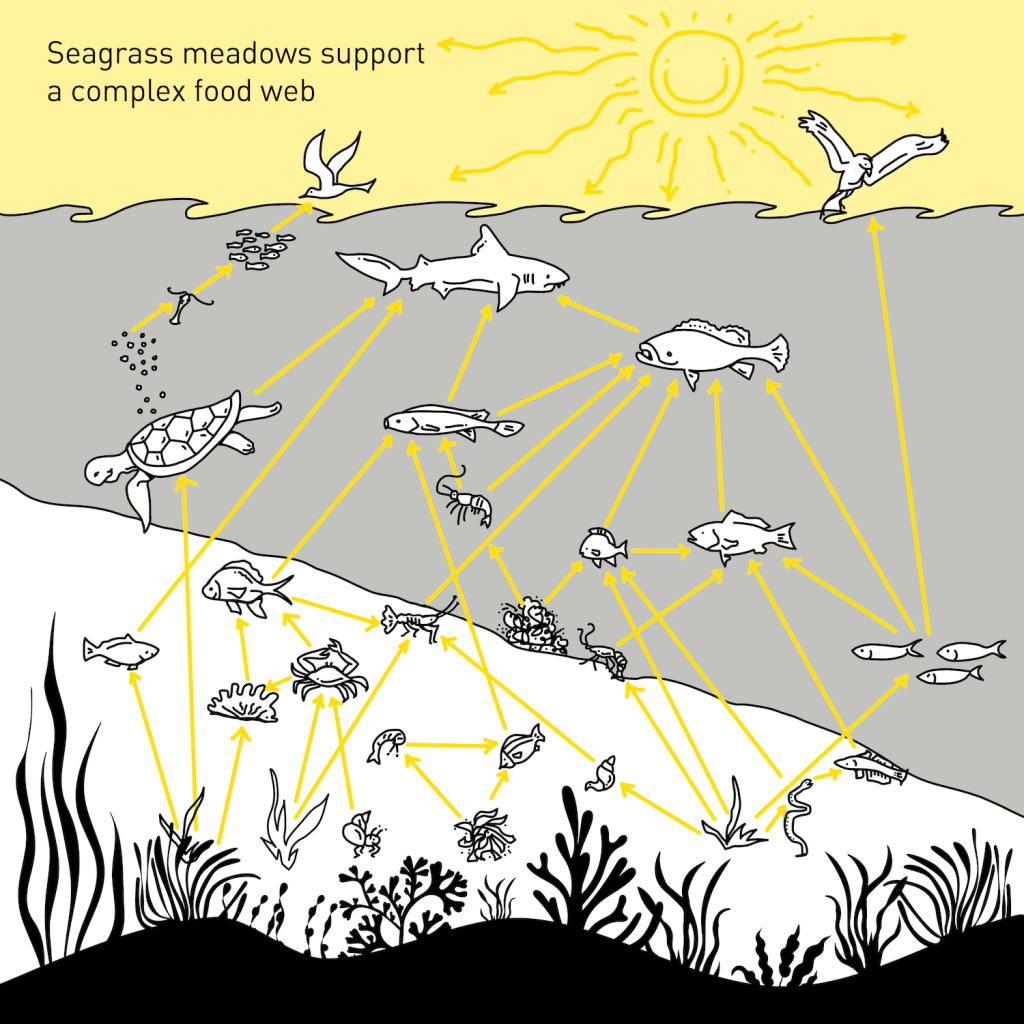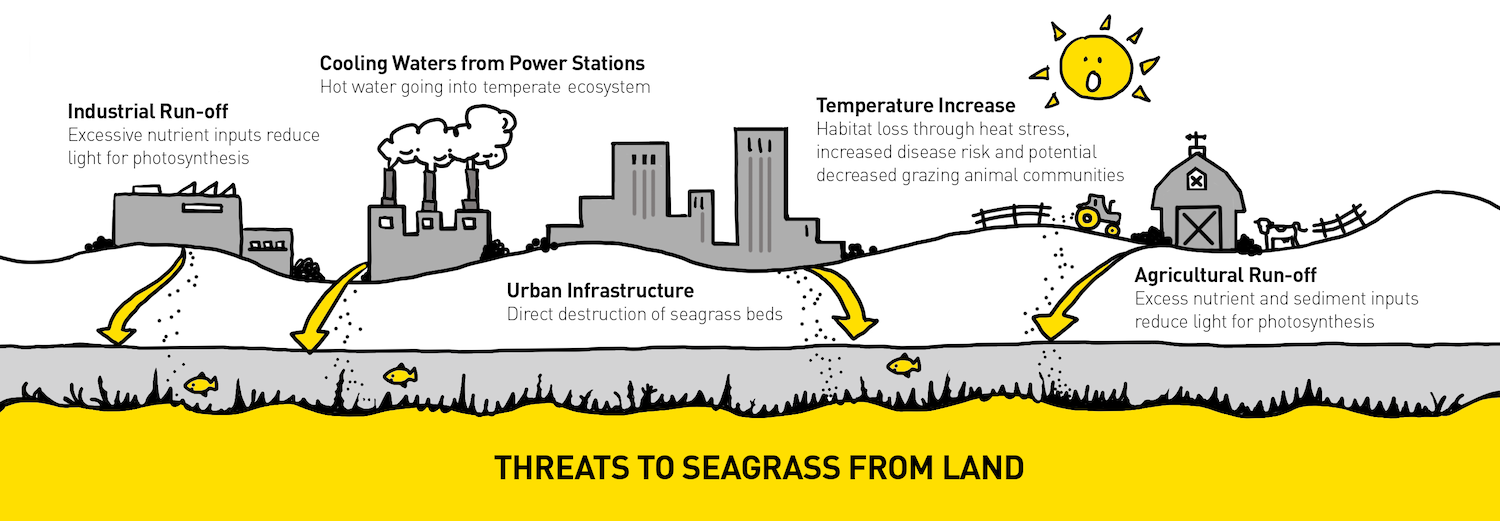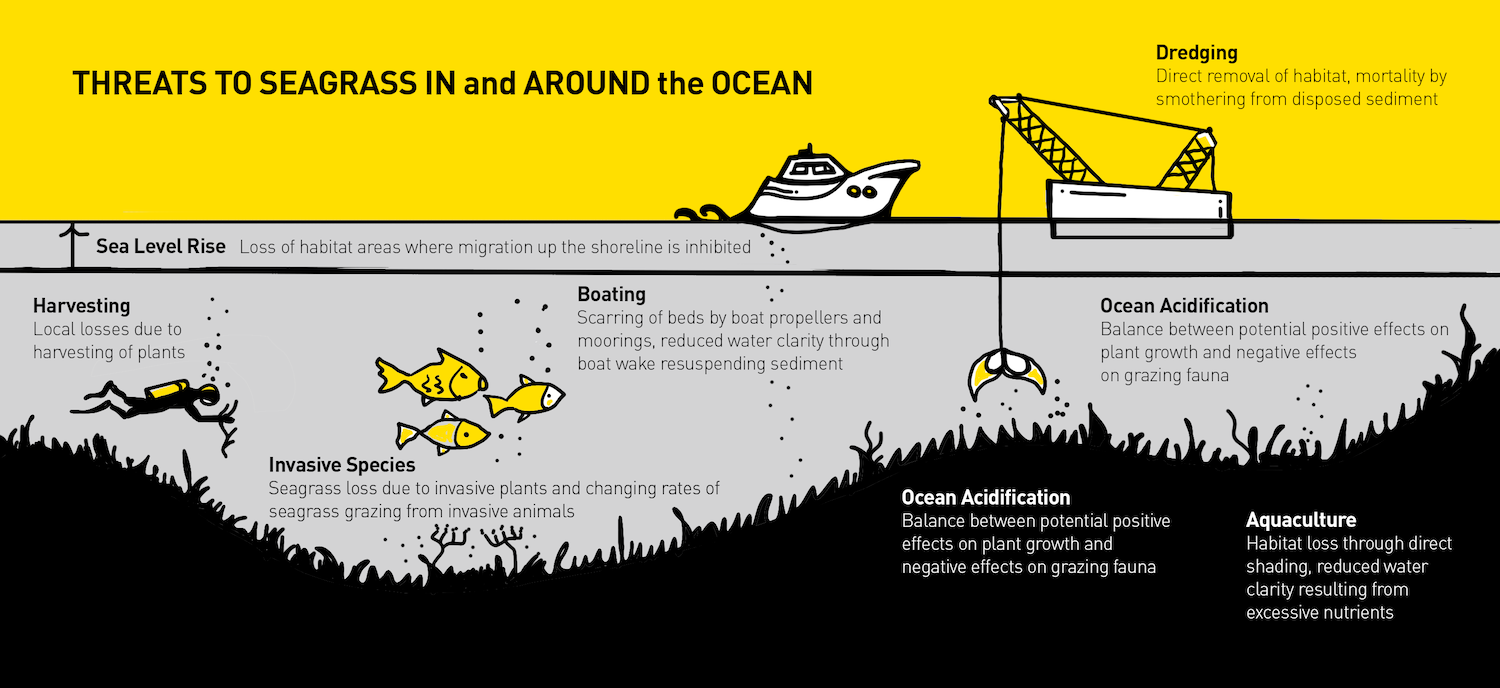An Everyday DNA blog article
Written by: Sarah Sharman, PhD
Illustrated by: Cathleen Shaw
Imagine standing on a sandy beach, the salty breeze caressing your cheeks. You gaze at the endless horizon where the sky meets the vast ocean. The sheer magnitude of the sea fills you with awe and wonder, reminding you of the incredible power and beauty of nature. But oceans are more than just breathtaking landscapes – they are the beating heart of our planet, essential to the very existence of life as we know it.
Oceans play a crucial role in regulating the Earth’s climate. They absorb massive amounts of heat from the sun and help distribute it across the globe through ocean currents, maintaining the delicate balance that sustains all living creatures. Oceans are also home to a remarkable variety of marine life, from tiny plankton to giant whales, forming complex ecosystems that support countless species.
In shallow waters near the shores of oceans around the world lives an underappreciated organism that helps maintain the health and vitality of its beautiful and valuable habitat: seagrasses. Unfortunately, climate change, rising ocean temperatures, and overfishing threaten this important ecosystem. Let’s plunge into the depths of the ocean to learn more about this hidden hero and the ongoing efforts to understand and remediate them.
What are seagrasses?
The star of this story, seagrasses, are flowering plants that grow underwater in salty and brackish waters worldwide, typically along gently sloping, protected coastlines. Seagrasses are land plants that adapted over millions of years to live underwater. Notably, seagrasses are the only flowering plant that evolved to return back to the sea. They are part of a group of plants called monocotyledons, which also includes grasses that grow on land, lilies, and palms.

Seagrasses share many features with their terrestrial relatives. They have roots, stems, and leaves. They reproduce sexually, producing flowers and seeds, but can also grow through clonal expansion, extending their rhizomes and producing large stands of clones. Seagrasses rely on photosynthesis to create the sugar and oxygen required for their growth. Their roots and rhizomes (thicker horizontal stems) anchor the plants and absorb nutrients from the ocean floor. Unlike their land-dwelling relatives, seagrasses lack stomata–the tiny pores on leaves that open and close so they can control water and gas exchange–but have a thin layer that allows gasses and nutrients to diffuse directly into and out of the leaves from the water.
There are 72 species of seagrasses commonly divided into four main groups: Zosteraceae, Hydrocharitaceae, Posidoniaceae, and Cymodoceaceae. Their common names, like eelgrass, turtle grass, tape grass, shoal grass, and spoon grass, reflect their many shapes, sizes, and roles in marine ecosystems. Seagrasses range from species with long flat blades resembling ribbons to fern or paddle-shaped leaves, cylindrical or spaghetti blades to branching shoots.
Seagrass meadow ecosystems
Seagrasses can form dense underwater meadows, some large enough to be seen from space. Like grasslands and meadows on land, seagrass meadows are great places for animals and other organisms to live, hunt, and hide. Seagrass meadows serve as vital nursery habitats, fostering a bustling community of marine life.
The abundance of life in seagrass meadows is truly astonishing. A single acre can support over 40,000 fish and a staggering 50 million small invertebrates, making it a biodiversity hotspot compared to adjacent bare sandy areas. The seagrass canopy offers shelter to small invertebrates like crabs, shrimp, and various crustaceans, as well as juvenile fish and smaller species. Algae, microalgae, bacteria, and invertebrates thrive as “epiphytes” on the living seagrass leaves, similar to lichens and Spanish moss on trees. The diverse array of organisms clustered around the seagrass blades attracts larger animals, like fish, sharks, turtles, marine mammals like dugongs and manatees, and more, creating a lively ecosystem.
Seagrass meadows are vital feeding grounds for numerous species, contributing to a diverse food web. Large grazers like manatees, dugongs, green sea turtles, and geese rely on living leaves for their diet. Epiphytic organisms on seagrass blades provide sustenance and critical nitrogen extraction for larger animals through certain bacteria. Small invertebrate mesograzers, such as crustaceans and snails, feed on the epiphytes, supporting seagrass growth and serving as important links in the coastal food web, eventually consumed by larger crustaceans, fish, and birds.

Seagrass meadows are invaluable ecosystems that play a crucial role in maintaining the health and balance of our oceans. In addition to their role in supporting biodiversity, seagrass meadows are also unsung heroes when it comes to coastal protection. Their dense root systems help stabilize sediments and prevent erosion, acting as a natural buffer against storm surges and wave action. They safeguard coastlines and coastal communities from the devastating effects of extreme weather events.
Humans have used seagrasses for over 10,000 years. They fertilize fields, insulate houses, weave furniture, thatch roofs, make bandages, and fill mattresses and seats. Seagrass meadows are important nursery habitats for many commercially and recreationally valuable fish and shellfish species. They support fish populations and contribute to fisheries production. This, in turn, enhances food security for communities that rely on fishing as a primary source of sustenance and income.
Seagrasses can capture and store a large amount of carbon from the atmosphere. Like trees take carbon from the air to build their trunks, seagrasses take carbon from the water to build their leaves and roots. As parts of the seagrass plants and associated organisms die and decay, they can collect on the seafloor and become buried, trapped in the sediment. The carbon stored in sediments from coastal ecosystems is known as “blue carbon” because it is stored in the sea. While seagrasses occupy only 0.2 percent of the total ocean floor, they are estimated to store carbon equal to over half of the global green carbon stored in land plants and their soil.
Threats and Conservation
Unfortunately, seagrasses are in trouble. It’s estimated that 29 percent of seagrass meadows have died off in the past century. Today, we’re losing about 2 football fields of seagrass each hour. This is troubling because seagrass losses impact marine biodiversity, the health of other marine ecosystems, and human livelihoods.

Physical disturbances, such as wind-driven waves and storms, can damage seagrass beds. Certain animals, like skates and rays, disrupt seagrass by disturbing the rhizomes and roots while foraging for buried clams and invertebrates. Nevertheless, the primary cause of seagrass bed losses in recent decades stems from human activities, both directly and indirectly.
Human-induced factors, such as nutrient runoff from fertilizers and pollution, result in algal blooms that obstruct vital sunlight for seagrass growth. Moreover, dredging directly removes seagrass plants and reduces light penetration due to increased sediment in the water. Boat anchors and propellers inflict “scars” on seagrass beds, causing sections of seagrass to perish and fragment the habitat. Adding to these threats, rising seawater temperatures also pose a risk to seagrass health.

While some fast-growing seagrass meadows can recover from disturbances, many grow slowly over centuries, rendering them highly vulnerable and slow to regenerate. Effective management strategies for seagrass protection primarily revolve around preserving their biodiversity and the valuable services these habitats offer humans and ecosystems. Various actions can aid seagrasses, including limiting damaging practices like excessive trawling, dredging, runoff pollution, and harmful fishing techniques. Furthermore, initiatives aimed at rebuilding and restoring seagrass beds are underway, often involving planting seeds or seedlings cultivated in aquaria and transplanting adult seagrasses from healthy meadows into affected areas.
Genomics to the Rescue!
Despite recovery efforts, seagrass populations are still in trouble globally. Because of their important ecosystem services, scientists and conservationists worldwide seek ways to protect and restore seagrass habitats. Scientists at the HudsonAlpha Institute for Biotechnology Genome Sequencing Center are part of a collaborative effort to use genomics to better understand seagrasses and how we can help them thrive in our changing world.
The entire genome of one seagrass, the eelgrass Zostera marina, was sequenced in 2016, helping scientists understand how these plants adapted to life in the sea and how they may respond to climate warming. The genome is an exceptional resource that supports a wide range of research topics, from the adaptation of marine ecosystems under climate warming and its role in carbon sequestration to unraveling the mechanisms of salt tolerance that could help assist the breeding of crop plants on land.
In their most recent project, HudsonAlpha scientists led by Adam Healey, PhD, helped use genomics to trace eelgrass’s geographic spread. Seagrasses are known to have originated in the coastal northwest Pacific Ocean and then spread throughout the Pacific, Atlantic, and Mediterranean. The team found that eelgrass ventured across the Pacific, not once but twice, likely riding the North Pacific Current. Astonishingly, this intrepid plant arrived in the Atlantic Ocean just a mere 243,000 years ago, a far cry from the previously believed 3.5 million years. Eelgrass made its mark in the Mediterranean approximately 44,000 years ago, and its modern-day populations along the Atlantic coast trace back only 19,000 years. However, these recent migrations have led to genetic bottlenecks, reducing eelgrass diversity in the Atlantic and potentially making it more vulnerable to climate change and other challenges.
Understanding the diversity within the Pacific populations of eelgrass will be critical to protecting vulnerable populations in Atlantic regions. Pacific populations are considered the geographic origin of the species and have already experienced strong climatic shifts during global dispersal and during glacial expansion/retraction. To better understand their diversity, HudsonAlpha and collaborators are working to develop a reference genome for Pacific eelgrass. Because of their extreme adaptation from land to sea, seagrasses provide a unique opportunity to study the adaptations involved, many of which could be applied to other plants, including crops or other vulnerable species.


